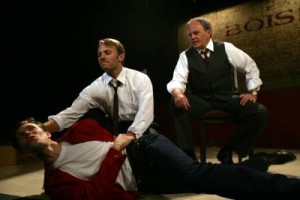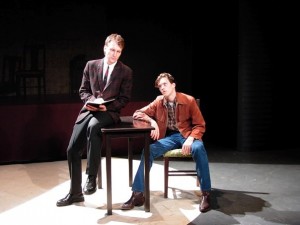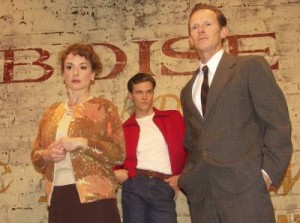RECOMMENDED
The 1950s are often thought of as “happy days” for the U.S., yet a closer look reveals a not so happy picture for many Americans of the era. Segregation was the law in the once Confederate South, liberal minded Americans were being branded Communists by Senator Joe McCarthy and his ilk, and in Boise, Idaho, another albeit less famous witch-hunt was underway.
In late 1955, hundreds of Boise men found themselves named as “suspected homosexuals” for allegedly having committed “infamous crimes against nature.” Their names and faces were splashed across newspaper pages, families and lives were destroyed, and many of these “criminals” were sentenced to prison, one of them for life.
Gene Franklin Smith’s Boise U.S.A., the third and final production of Salem K Theatre Company’s first season, dramatizes the Idaho witch-hunts of 1955-1956, centering on 10 major figures in the investigations.
The play begins with a blowjob in a dark alley and an arrest. 17-year-old Eldon Halverson (Westley Thornton), the blowee (for pay), seems not to mind being taken to jail. “I’m sick of sleeping in the park anyway,” he declares.
Senior City Councilman, Harold T. “Buck” Jones (George McDaniel) is outraged by the presence of homosexuals in Boise. “We have to protect our community!” he roars, and when county prosecutor Blaine Evans (Nic D’Avirro) informs him that the crime committed is a felony offense punishable by five years in the State Penn, Buck is shocked. “That’s all?” he exclaims.
Meanwhile, in France, Dr. Jack Butler (alternate Scott Victor Nelson) and wife Marjorie (Audrey Moore) learn that Boise’s Division of Mental Health is looking for a new director. Jack, who has been doing research on “sexual deviancy,” is thinking of staying on in Europe another three years, but Marjorie pleads with him to return to Boise. “Daddy (Buck Jones) will arrange for everything,” she tells him, adding that it’s time to stop running from the swimming death of their young son Harry.
Popular bank vice-president Joe Moore (Kris Kamm) is having breakfast with his wife Doris (Melissa Kite), who wonders if “a chain link fence is really enough to keep the schoolyard safe.” Little does she know that Joe was once in love with a fellow soldier named Pete, and that he and Eldon have also had intimate relations.
Aiding in the investigation is former FBI agent Will Fairchild (Craig Robert Young), hired to interrogate the alleged homosexuals, many of whom are married and have children.
Completing the cast of characters are two more members of Buck Jones’ family, son Frank (Matty Ferraro) and brother Herbert (Cameron Mitchell Jr.). Frank is a West Point cadet and former Eagle Scout (with an incredible 103 merit badges). He also has a secret, one which Uncle Herbert shares, though from the moment the latter swishes onstage, it’s pretty clear what that secret is.
As the investigation progresses, an interesting piece of information comes to light. Apparently, 1950s homosexuals (at least those in Boise) smoked Pall Mall cigarettes, whose slogan was “Wherever particular people congregate,” as a way of identifying each other. (Who knew?) Less likely to be true is agent Fairchild’s claim that “Russia sends their homosexuals here to infiltrate our society.”
We also learn that Eldon, who left home at 12, has spent the five years since then on and off at the YMCA, and that the Y is where he met Joe, who coaches boxing there. Cocky Eldon seems ahead of his time, unashamed of his sexuality to the point of flirtatiousness with interrogator Fairchild. “I like older men,” he tells the hunky Fairchild with a wink.
Joe considers pleading guilty, on condition that, rather than do time in prison, he be sentenced to a shorter (18 month) term in a mental hospital. “I didn’t do all those things,” he tells Jack, “but I’m not innocent.” Joe can’t understand why his wife isn’t enough. “It’s a mental illness, isn’t it?” he asks the doctor.
Joe Moore’s gradual realization that perhaps he’s not mentally ill is one of the more powerful aspects of Boise U.S.A. Sentenced to seven years in the penitentiary, Joe discovers Walt Whitman in prison. In discussions with Jack, his court appointed therapist, Joe can’t get over that Whitman was “queer.” Reading one of Whitman’s poems, Joe marvels, “That’s how I felt with Pete. That we could conquer everything.”
The real hero of Boise U.S.A. turns out to be gay Uncle Herbert, who accuses FBI agent Fairchild of being “a cruel black-hearted cocksucker” who “go(es) after queers to deflect suspicion.” Herbert happens to know J. Edgar Hoover and Hoover’s partner (in crime-prevention and the boudoir) Clyde Tolson, something which comes in handy in righting at least some of the wrongs inflicted on his fellow gays.
If all this information seems a bit too much to keep straight in a review, it also seemed so to me as I watched Boise U.S.A. With a running time of less than two hours (including intermission), the play’s dozens of short scenes make it somewhat difficult to figure out and recall just who everyone is and what they’re up to.
With so many scenes and complex (though very effective) blocking by director Arturo Castillo, some of the cast members may not have had quite enough rehearsal time to fully develop their characterizations, at least so it seemed in the first performance after the show’s opening weekend. Still, a number of the cast members do noteworthy work.
Thornton is a particular standout as teen tempter Eldon. The actor has real star potential, commanding the stage and exuding sex appeal in each of his all too brief appearances. Perhaps no one in the cast captures the look and feel of the era better than Kite, who could easily have stepped out of Father Knows Best. In her final scene, a prison visit with an excellent Kamm as husband Joe, the stage truly takes fire. Broadway vet McDaniel is a powerful Buck Jones, and Mitchell creates a real three-dimensional Uncle Herbert, a role which in lesser hands would have been mere stereotype. Young has some strong moments as the FBI closet case, though the British actor’s American accent seems a bit off. Nelson does creditable work in his first time at bat as Jack.
As in Salem K’s recent Snake In The Grass, the best elements of Boise U.S.A. are the contributions of its superlative design team, who have been on board for all three Salem K productions. Laura Fine Hawkes’ excellent set allows for quick scene changes, and makes especially fine use of the Matrix’s brick upstage wall, painted to resemble the painted-on ads which adorned many downtown building walls of the era. Leigh Allen once again proves why she was the deserving recipient of this year’s L.A. Drama Critics’ Circle lifetime achievement award for lighting design. May Routh’s costumes are an excellent evocation of the mid-1950s.
Best of all is Eric Snodgrass’s sound design, particularly outstanding in several scenes involving the “Boise voices.” In a press conference and later at a town meeting, the recorded voices seem to be coming live from all parts of the theater, perfectly integrated with the voices of the onstage actors.
Boise U.S.A. is actually that rare play which could stand to be a bit longer, with lengthier scenes clarifying certain plot lines. Performances, some of which are a bit underdeveloped, are likely to improve as the run progresses.
Boise U.S.A. has particular resonance for those in the audience who can recall pre-Stonewall days. It is also a production which every young gay person should see. In these days when the majority of Californians see nothing immoral about gay relationships, it would behoove those who have grown up in this more tolerant and accepting society to take a look back at a time not so long ago when being gay meant being a criminal (as it still does in many parts of the world).
At the play’s end, one of the characters comments that it is “as if it never happened,” to which he receives this prophetic response:
“It did. It will again.”
Matrix Theatre, 7657 Melrose Ave., Los Angeles.
www.salemktheatreco.org
www.plays411.com/boise
–Steven Stanley
May 22, 2008
Photos: J. Lucien Scott Photography and Ernie Beck





 Since 2007, Steven Stanley's StageSceneLA.com has spotlighted the best in Southern California theater via reviews, interviews, and its annual StageSceneLA Scenies.
Since 2007, Steven Stanley's StageSceneLA.com has spotlighted the best in Southern California theater via reviews, interviews, and its annual StageSceneLA Scenies.







 COPYRIGHT 2024 STEVEN STANLEY :: DESIGN BY
COPYRIGHT 2024 STEVEN STANLEY :: DESIGN BY